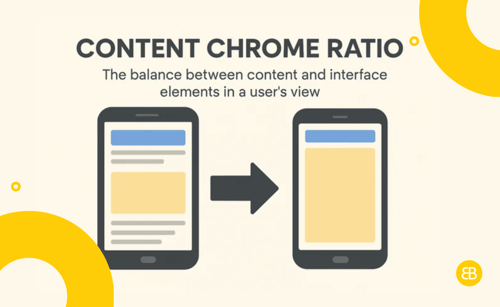Content Chrome Ratio: Boosting Usability and App Experience

Content chrome ratio refers to the balance between your app’s core content and the surrounding interface elements (like headers, sidebars, buttons). A good ratio prioritises the content that users came for—without cluttering it with excessive UI “chrome.”
Why Content Chrome Ratio Matters
-
Enhances clarity by focusing the user's attention on meaningful content
-
Reduces visual noise and screen fatigue
-
Improves mobile usability with cleaner, tighter layouts
-
Boosts user engagement with well-presented, easy-to-read content
-
Supports minimal design trends that drive app credibility
When to Use Content Chrome Ratio
-
Designing mobile, tablet, or responsive layouts
-
Reviewing screen space allocation in wireframes or prototypes
-
Auditing user drop-off due to cluttered interfaces
-
Planning for cleaner UI during a redesign
-
Optimising UX for content-heavy apps
Real-World Example
In the project, we improved the content chrome ratio by simplifying the top nav and collapsing secondary actions. This made room for the main dashboard content, helping users focus and interact more effectively.
Founder Insight
Too much chrome dilutes your app’s core value. Users don’t come for fancy headers—they come to get something done. Strip away distractions and let the content breathe.
Key Metrics / Concepts
-
Content-to-Chrome Ratio – The proportion of screen space given to content vs interface
-
Scroll Depth – Indicates whether users are actually consuming the content
-
User Focus Time – How long users interact with core content rather than UI elements
Tools & Technologies
-
Figma / Adobe XD – For visual layout testing and ratio adjustment
-
Hotjar / Mixpanel – To measure where users click and what distracts them
-
Flutter / React Native – Responsive platforms for dynamic chrome optimisation
What’s Next / Future Trends
AI-driven UI tools will automatically adjust chrome elements based on context—prioritising content during certain actions and reducing distractions. Think adaptive interfaces that shift based on what users need most in the moment.
Related Terms
Helpful Resources
Is your UI taking up more space than your actual content?
Let us help you rebalance it. Book a discovery call and optimise your app’s content-first experience.